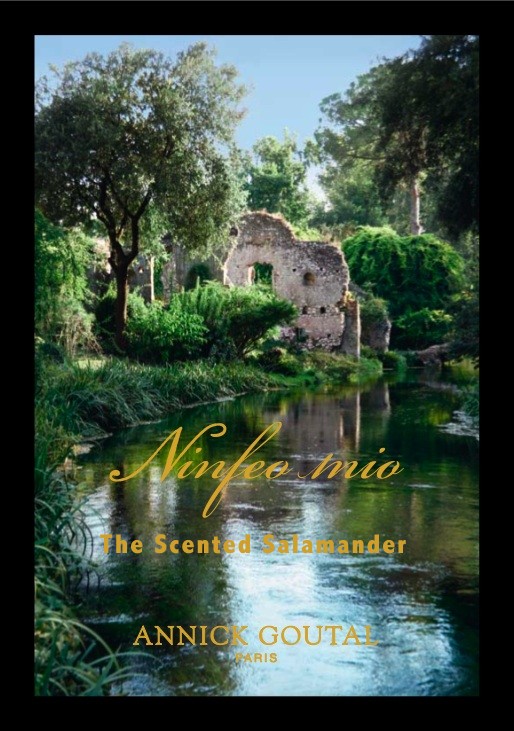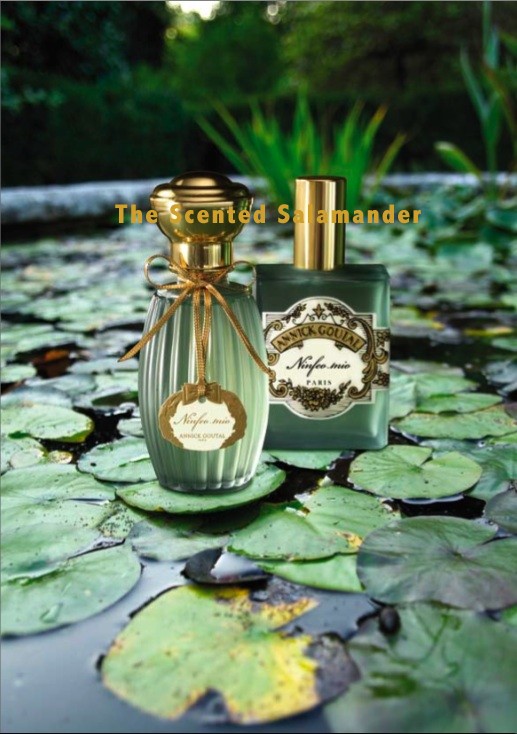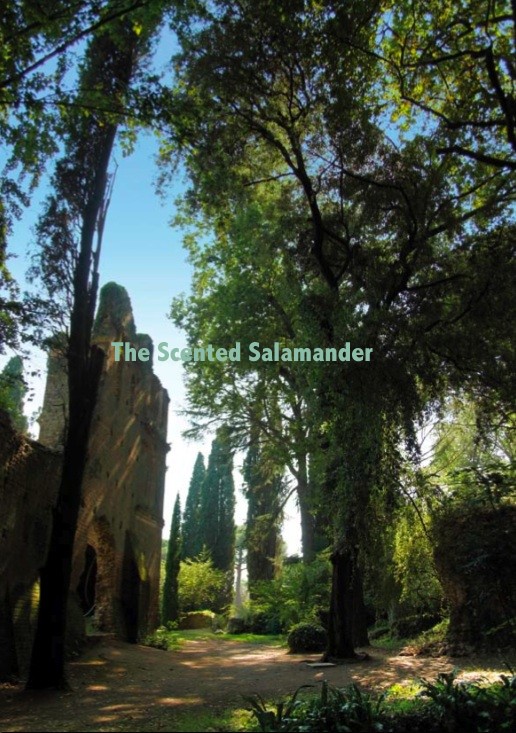Annick Goutal Ninfeo Mio (2010): Dual Spiritual and Gourmand Fig {Perfume Review & Musings}

Ninfeo Mio is named after a masterpiece of garden art, the latter the happenstance result of the Italian Duke Onorato Caetani having married an English woman, Ada, with a passion for greenery. The Giardino di Ninfa located in the vicinity of Rome appears today to be the embodiment of vegetal and Edenic voluptuousness done in the English romantic landscape style, a priori a good fit for the universe of the house of Annick Goutal who have drawn constant inspiration from garden impressions and a Romantic engagement with nature from the early beginnings...
 In Ninfa, there is even a Gothic streak of romanticism apparent in the medieval ruins
that compose the park and on which the half-effaced images of saints
can still be seen. For the authors of Mandragore and Mandragore
Pourpre, perfumer Isabelle Doyen and designer Camille Goutal,
this medieval setting could only come as a reinforcement of their own
symbolic universe.
In Ninfa, there is even a Gothic streak of romanticism apparent in the medieval ruins
that compose the park and on which the half-effaced images of saints
can still be seen. For the authors of Mandragore and Mandragore
Pourpre, perfumer Isabelle Doyen and designer Camille Goutal,
this medieval setting could only come as a reinforcement of their own
symbolic universe.What was intended to be a Garden of the Hesperides scent transformed itself into a Garden of Ninfa perfume.

A word about the name of the fragrance might be useful in order to better capture the inspiration of the scent. Personally, it helps me better apprehend the aquatic, pale facet of Ninfeo Mio. A "ninfeo" or Nymphaeum or Nymphaion is a sacred edifice from the antiquity consecrated to water deities or nymphs and consequently built near fountains and springs. While the river in Ninfa is actually called Ninfa, one can feel the poetry of a perfume called Ninfeo Mio which would mean something like My Sacred Temple to the Nymph of These Waters.
Ninfeo Mio at first is deliciously fresh, verdant, thirst-quenching and complex with a profuse spray of green and citrus notes mixed in with more aromatic herbal hints. Annick Goutal know very well how to do herbs and to tap their simple charms to add atmospheric notes to their scents. Sables, Mandragore are moody and mysterious in part due to a research on quirky herbal-y hints. In Ninfeo Mio, the aromatic facet introduces a measure of cool reflexivity and distance from the happy, effusive spring-like notes but without taking center stage.
After this kaleidoscopic green and fresh opening which feels like cool leafy and grassy fireworks on which lemon juice and coconut were drizzled, the composition lets through a warmer balmy sweet accord of vanilla and bergamot recognizable as the classic sweet powdery "note" of Shalimar by Guerlain.
Little by little, the perfume takes on a more characteristic fig personality which is treated a bit in a standard fashion to my nose as fruity and milky with coconut-y and salty notes. A lime-y facet fortunately counterbalances this thrust. The citrus facet is more perceptible after I have sprayed on the perfume a few times and the citrus oils concentrate better and remain longer. The fruity fig note reminds me for part of it of the fig wave that washed over soaps a few years ago in France as the new in-note in suds bars followed by fresh vine tomatoes a couple of years later. I would probably be more immediately under the spell of this fig rendering if I had not used and smelled one too many fig soap, shower gel and even fig oils. This is a common pitfall both for consumers and perfumers. The latter have to navigate in principle cautiously to avoid such identifications although lately, they have turned the tide completely by copying soaps and detergents.

What remains more Goutalian here is the juxtaposition of this off-the-shelf fig note with the more sophisticated citruses of l'Eau d'Hadrien which are still able to convey a sense of being a shimmering gold brocade. This is not easy a task as lemony notes are everywhere in our daily lives.To be able to offer a sensation that translates as gold muslin rather than lemonade - or even Lemon Pledge, god forbid - is a feat to be underlined.
I think that the house was well-inspired to keep this signature accord to personalize the more standard fig accord in my view as the first one seems to lack a bit of a creative process while the second one obviously has had much time to mature since the creation of l'Eau d'Hadrien followed by Mandragore and Les Nuits d'Hadrien. If you compare the fig note in Ninfeo Mio with the one of Un Jardin en Méditerrannée by Hermès for instance, I would say that the latter is more thoughtful and original. From a commercial vantage point, l'Eau d'Hadrien is a confirmed bestseller of the house and so it would make sense to please patrons who might feel conflicted about using a new fresh summery perfume from Annick Goutal while having to forsake the elegant hesperides of l'Eau d'Hadrien.
Ninfeo Mio however distinguishes itself from l'Eau d'Hadrien in that it is also sweet, milky, fruity and green. I personally find the fig impression, again, at times, a bit heavy, caramel-y and playing on the "regressive" register as is customary to say in the jargon of perfumery which means that it tends to be child-like and simple in taste-orientation with a bias towards candy and pastry flavors. There is however a green sappy, grassy and lime-y nuance that attempts to counterbalance the gourmand aspect of the fig and succeeds at times but gives way at other times to what the French like to call a "doudou" scent to denote a comfort perfume. This comfort facet is willed as is clear from the press material and not a skin idiosyncracy. A translation in English might be a "blankee" perfume in homage to Linus Van Pelt's most cherished and dependable companion. This is not just subjective cultural speculation of mine: French designer Jean-Charles de Castelbaljac even launched a perfume that was meant to evoke an iconic blankee both in scent and perfume bottle shape.
Overtime Ninfeo Mio refines a bit this gustatory and dessert-y fig motif. The scent becomes more abstract and while still comforting becomes better meshed with a more sensual skin impression. The fragrance is still sweet but more evanescent. It is an Eau de Toilette concentration and is meant to perfume lightly during the hot days of spring and summer where it should do well.The salty edge of the coconut milk note used to build the fig accord comes through a bit more, going in the direction of the Thai coconut curry sensation found in Jo Malone Sweet Lime and Cedar.
Depending on how and how much you will spray it on, it seems, the perfume will be more fig-y and sweet or more citrus-y and crystalline. I prefer the fig be buried as much as possible to let the transparent green veil of the nymph enshroud me and really evoke the virtues of the coolness and water-dispensing deity who lives by the river Ninfa. Perhaps there is a fig tree in the shade of this water-splashed temple, but I wished its fruits were fresher and subtler rather than veering in the direction of confectionery sweets or fig-filled macaron.
Ninfeo Mio is for those who cannot bypass a fig scent and can easily imagine sleeping in the shade of a tree by a green river thanks to a few suggestive notes.
Perfume notes are listed here.










The more I hear about Ninfeo Mio the better it sounds! I adore fig when it's done right, and this sounds just lovely to me. OF course, those picture don't hurt either! What a wonderful garden.